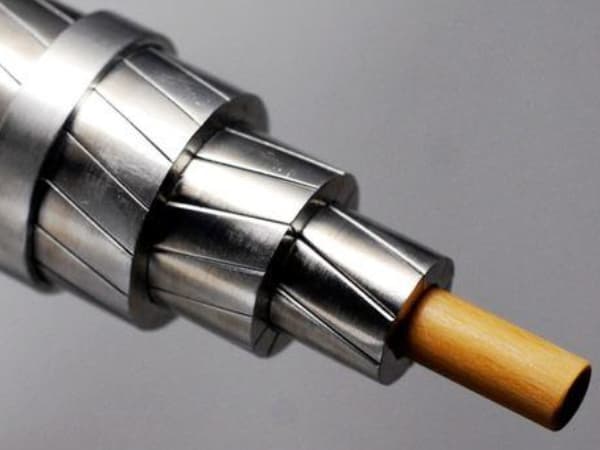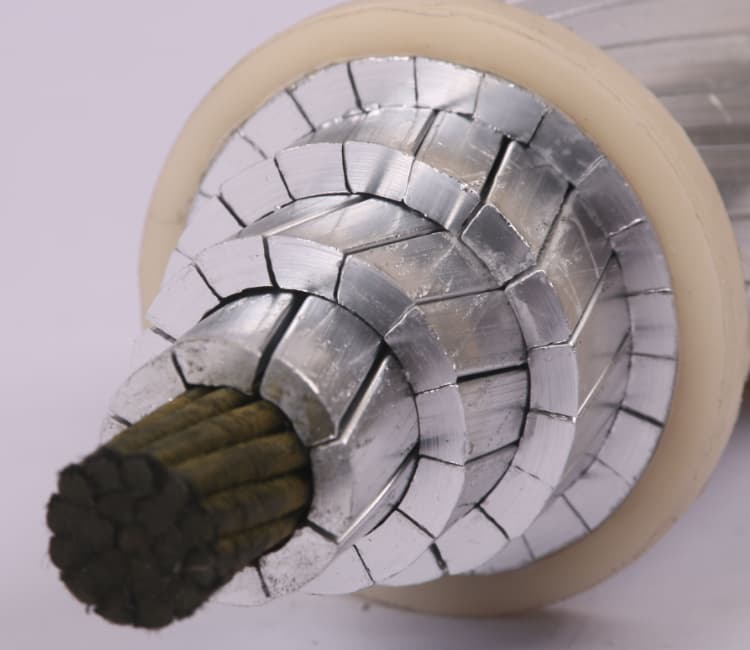ACCC 지휘자
ACCC 지휘자는 무엇입니까?
ACCC 지휘자, 알루미늄 도체 복합 코어, 경량 탄소-유리 섬유 복합재로 제작된 중앙 코어를 갖추고 있습니다., 그 주위에는 하나 이상의 사다리꼴 모양의 단단한 인발 및 단련 층이 있습니다. 1350-0 알루미늄 전선은 동심원으로 꼬여 있습니다.. 기존 지휘자와 비교하여, ACCC 컨덕터는 훨씬 더 강한 탄소 섬유 코어를 사용합니다. (25%) 그리고 더 가벼워요 (60%) 일반적으로 사용되는 강철 코어보다.
이 혁신적인 디자인을 통해 ACCC 도체는 알루미늄 함량을 이상으로 늘릴 수 있습니다. 28% 전체 직경이나 무게를 변경하지 않고. 견고한 구조로 인해 높은 온도에서 효율적으로 작동하는 동시에 작동 범위 전반에 걸쳐 우수한 새그 특성을 유지할 수 있습니다.. 기존선을 재구축하여 송전용량을 증대시켜야 하는 경우, ACCC 지휘자가 선호되는 선택입니다.
뿐만 아니라, ACCC 컨덕터는 매우 낮은 라인 손실과 탁월한 자체 감쇠 특성을 제공합니다.. 높은 강도 대 중량 비율로 더 긴 스팬을 허용합니다., 새로운 송전선 건설에 드는 전체 비용을 절감합니다.. 예를 들어 제품, ACCC 드레이크 지휘자
ACCC 지휘자 표준
ASTM B987 / B987M – 20 "머리 위 전기 전도체에 사용하기 위한 탄소 섬유 열경화성 중합체 매트릭스 복합 코어의 표준 사양."
1350-ASTM B에 따른 O 강화 알루미늄 와이어 609 또는 EN 50540
하이브리드 탄소 및 유리 섬유 코어 (복합 코어) ASTM B987에 따르면
ACCC 도체는 꼬임 길이를 표시해야 합니다. (비율) ASTM B를 준수하는 것 857 또는 EN 50540.
지휘자 ACCC 장점
복합 코어 ACCC 지휘자 기존 ACSR 케이블의 강철 코어를 탄소와 유리 섬유의 고강도 복합재로 대체하여 송전선의 용량을 향상시킵니다.. 이러한 혁신을 통해 도체는 비슷한 크기와 무게의 기존 ACSR 케이블보다 약 2배 많은 전류를 전달할 수 있습니다.. 이러한 기능 덕분에 ACCC 도체는 타워와 절연체를 교체할 필요 없이 기존 송전선을 업그레이드하는 데 특히 유리합니다..
비용과 자재 절감을 넘어서, ACCC로의 업그레이드는 일상적인 유지 관리의 일부로 수행될 수 있습니다., 신규 건설에 일반적으로 요구되는 시간이 많이 소요되는 허가 절차를 우회합니다..
ACCC 도체의 주요 장점은 다음과 같습니다.:
무게 효율성: 사다리꼴 알루미늄 스트랜드와 더 가벼운 복합 코어를 활용하여, ACCC 도체는 동일한 직경 내에서 알루미늄의 양을 최대화합니다., 전도성 향상.
온도 성능: ACSR에 비해 열팽창 계수가 현저히 낮습니다., ACCC 도체는 극 사이에 과도한 처짐 없이 훨씬 더 높은 온도에서 작동할 수 있습니다.. 이 특성을 통해 최대 180°C의 온도에서 연속 작동이 가능합니다., 기존 ACSR 도체의 한계를 훨씬 뛰어넘는.
실용적인 측면에서, 이러한 개선 사항은 더 많은 전류를 전달할 뿐만 아니라 더 낮은 전기 저항으로 인해 라인 손실도 감소하는 도체로 해석됩니다.. 이 기능은 최대 수요 또는 예상치 못한 스트레스 상황 동안 연속적인 오류를 방지하기 위해 초과 용량을 제공함으로써 그리드 신뢰성에 기여합니다.. 따라서, 최대 온도에서 작동하면 더 높은 손실이 발생할 수 있지만, 전력망의 전반적인 효율성과 탄력성이 크게 향상되었습니다..


